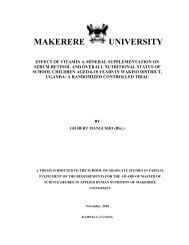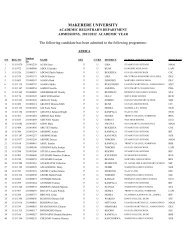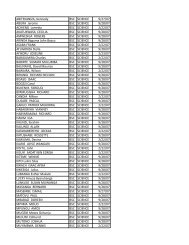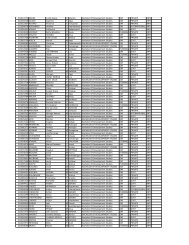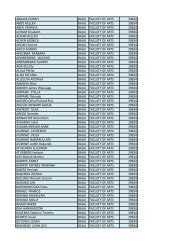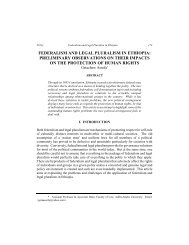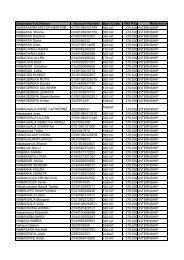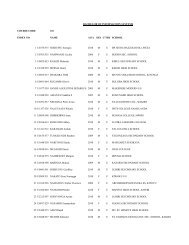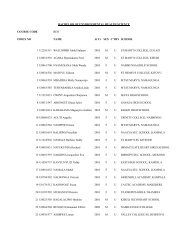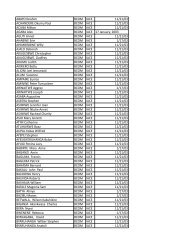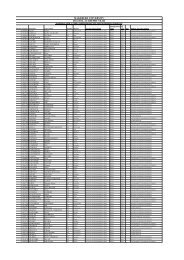Vulnerability to drought, adaptation and coping strategies among
Vulnerability to drought, adaptation and coping strategies among
Vulnerability to drought, adaptation and coping strategies among
Create successful ePaper yourself
Turn your PDF publications into a flip-book with our unique Google optimized e-Paper software.
Abstract<br />
Résumé<br />
Second RUFORUM Biennial Meeting 20 - 24 September 2010, Entebbe, Ug<strong>and</strong>a<br />
Research Application Summary<br />
<strong>Vulnerability</strong> <strong>to</strong> <strong>drought</strong>, <strong>adaptation</strong> <strong>and</strong> <strong>coping</strong> <strong>strategies</strong> <strong>among</strong> agro-pas<strong>to</strong>ral<br />
communities in Botswana<br />
Kabo Mogotsi 1 , Nyangi<strong>to</strong>, M.M. 1 & Nyariki, D.M. 1<br />
1 Range Management Section, Department of L<strong>and</strong> Resources Management <strong>and</strong> Agricultural<br />
Technology, College of Agriculture <strong>and</strong> Veterinary Sciences<br />
University of Nairobi, P. O. Box 29053-00226, Upper Kabete Campus, Kenya<br />
Corresponding author: kbmogotsi@yahoo.com<br />
With the increased threat of climate change effects on the<br />
African continent, this study was carried out <strong>to</strong> document the<br />
<strong>coping</strong> mechanisms against the rampant <strong>drought</strong>s by the agropas<strong>to</strong>ral<br />
communities in Botswana. The study was carried out<br />
in Kgalagadi North <strong>and</strong> Bobonong. Effects of <strong>drought</strong> in these<br />
areas included lives<strong>to</strong>ck death, reduced crop yields, low pasture<br />
production <strong>and</strong> increased distances <strong>to</strong> water lives<strong>to</strong>ck. Coping<br />
measures included enrolling in<strong>to</strong> government’s labour intensive<br />
Public Works Programme, harvesting larvae of Imbrasia belina<br />
with food or turning <strong>to</strong> other sources of income, <strong>and</strong> s<strong>to</strong>rage of<br />
crops during good harvests. Other means were planting <strong>drought</strong><br />
resistant crops, supplemental lives<strong>to</strong>ck feeding, transferring<br />
lives<strong>to</strong>ck <strong>to</strong> better areas, <strong>and</strong> selling off animals. These methods<br />
however did not ameliorate farmers’ problems. There is<br />
therefore need <strong>to</strong> have more holistic research efforts <strong>to</strong> tackle<br />
the effects of <strong>drought</strong> in Botswana <strong>and</strong> elsewhere in Africa.<br />
Key words: Climate change, desert, Imbrasia belina, lives<strong>to</strong>ck,<br />
pas<strong>to</strong>ralism<br />
Avec la menace accrue d’effets du changement climatique sur<br />
le continent africain, cette étude a été réalisée afin de<br />
documenter les mécanismes d’<strong>adaptation</strong> contre la sécheresse<br />
rampante que vivent les communautés agro-pas<strong>to</strong>rales au<br />
Botswana. L’étude a été réalisée dans le Nord Kgalagadi<br />
Bobonong. Les effets de la sécheresse dans ces domaines inclus<br />
la mort du bétail, la réduction des rendements des cultures, la<br />
faible production de pâturage et l’augmentation des distances<br />
pour abreuver le bétail. Les mesures d’<strong>adaptation</strong> comprennent<br />
l’inscription dans le travail intensif du programme du<br />
gouvernement dans les travaux publics, la récolte des larves de<br />
Imbrasia belina avec de la nourriture ou se <strong>to</strong>urner vers<br />
d’autres sources de revenu, et le s<strong>to</strong>ckage des cultures au cours<br />
de bonnes récoltes. D’autres moyens ont été la semence des<br />
cultures résistant à la sécheresse, l’alimentation supplémentaire<br />
75
Background<br />
Literature Summary<br />
Study Description<br />
Kabo Mogotsi et al.<br />
du bétail, le transfert du bétail dans les meilleures zones, et en<br />
vendant des animaux. Ces méthodes n’ont <strong>to</strong>utefois réduit les<br />
problèmes des agriculteurs. Il y a donc besoin de fournir des<br />
efforts de recherche plus globale de lutte contre les effets de la<br />
sécheresse au Botswana et ailleurs en Afrique.<br />
Mots clés: Changement climatique, le désert, Imbrasia belina,<br />
l’élevage, le pas<strong>to</strong>ralisme<br />
Botswana has experienced <strong>drought</strong>s in the past, continues <strong>to</strong><br />
do so <strong>and</strong> will likely be faced with even more frequent <strong>and</strong><br />
intense dry extremes in future. In a semi arid country whose<br />
two thirds are covered by infertile Kalahari s<strong>and</strong>s <strong>and</strong> heavily<br />
dependent on rain-fed agriculture, this scenario does not bode<br />
well for the rural population with limited livelihood options. But<br />
how have agro-pas<strong>to</strong>ral communities coped/adapted <strong>and</strong> even<br />
thrived in the past despite devastating <strong>drought</strong>s? What are some<br />
of the main determinants of household vulnerability <strong>to</strong> <strong>drought</strong>?<br />
Only after addressing this knowledge gap can communities’<br />
resilience <strong>to</strong> current <strong>and</strong> future climatic shocks be enhanced.<br />
This study therefore set out <strong>to</strong> examine the vulnerability of arid<br />
<strong>and</strong> semi arid agro-pas<strong>to</strong>ral communities in Botswana <strong>to</strong> <strong>drought</strong>s<br />
<strong>and</strong> their <strong>strategies</strong> <strong>to</strong> cope <strong>and</strong> adapt against such shocks.<br />
Future climate predictions (IPCC, 2001) indicate increased<br />
frequency <strong>and</strong> severity of <strong>drought</strong>s. With the majority of rural<br />
communities in Africa dependent on rain-fed subsistence<br />
agriculture, there is increased likelihood of disruption <strong>to</strong> their<br />
production systems. Some of the effects of <strong>drought</strong> in Botswana<br />
for example, include crop failure/low yields <strong>and</strong> reduced<br />
productivity of lives<strong>to</strong>ck pastures. These resultant production<br />
shortfalls immediately render households food insecure.<br />
<strong>Vulnerability</strong> varies <strong>among</strong> households <strong>and</strong> even communities<br />
depending on a number of fac<strong>to</strong>rs such as poverty (Dube <strong>and</strong><br />
Pickup, 2001) <strong>and</strong> experience with previous <strong>drought</strong>s. The poor<br />
natural resource base <strong>and</strong> aridity of most parts of Botswana<br />
are also cited as reasons for poverty <strong>and</strong> thus vulnerability (GoB,<br />
2008). Some of these fac<strong>to</strong>rs, according <strong>to</strong> Adger (2003) can<br />
determine the extent <strong>to</strong> which communities can successfully<br />
adapt or fail <strong>to</strong> adapt <strong>to</strong> climate-related risks. So, under which<br />
circumstances are agro-pas<strong>to</strong>ralists affected by moisture deficits<br />
in <strong>drought</strong>-prone Botswana <strong>and</strong> how do they scope?<br />
The study was conducted in two areas of Botswana during the<br />
2009/10 season. Kgalagadi North is part of Kgalagadi (Kalahari)<br />
76
Second RUFORUM Biennial Meeting 20 - 24 September 2010, Entebbe, Ug<strong>and</strong>a<br />
Research Application<br />
desert ecosystem, the driest district in western Botswana.<br />
Rainfall follows a uni-modal pattern <strong>and</strong> is generally highly<br />
variable <strong>and</strong> erratic. The soils of the area are arenosols. The<br />
vegetation type is southern Kalahari bush savanna. The other<br />
study site was in the Bobonong region in the wetter <strong>and</strong> more<br />
fertile eastern region. The main soil type in this region is Eutric<br />
Regosols <strong>and</strong> in some areas petric calcisols/chromic luvisols.<br />
The vegetation consists of Colophospermum mopane/<br />
Combretum apiculatum tree savanna.<br />
In each study site, <strong>to</strong>p soil samples (0-7.5cm) were collected in<br />
a representative grazing area. The same transects were used<br />
<strong>to</strong> collect data on vegetation parameters (frequency, density<br />
<strong>and</strong> cover). St<strong>and</strong>ard questionnaires were administered <strong>to</strong><br />
r<strong>and</strong>omly chosen households from a representative sample of<br />
the respective communities. Data were analysed using SPSS.<br />
Where significant differences existed (p
Recommendation<br />
Kabo Mogotsi et al.<br />
To cope <strong>and</strong> adapt <strong>to</strong> <strong>drought</strong>s, 15% of the households in<br />
Bobonong area enroled in the governmnent’s Labour Intensive<br />
Public Works Programme, while harvesting of larvae of Imbrasia<br />
belina moth (locally known as phane) for consumption <strong>and</strong><br />
sale came in a close second at 13%. Another 11% sought<br />
alternative sources of income during <strong>drought</strong>s. Other <strong>strategies</strong><br />
included s<strong>to</strong>rage of crop harvests from good seasons (8%),<br />
supplementary feeding of lives<strong>to</strong>ck (8%), planting of <strong>drought</strong><br />
<strong>to</strong>lerant crops (7%) <strong>and</strong> moving s<strong>to</strong>ck <strong>to</strong> better pastures within<br />
the communal area (6%). In contrast, Kgalagadi North farmers<br />
supplemented lives<strong>to</strong>ck during <strong>drought</strong>s (22%), provided water<br />
for their lives<strong>to</strong>ck (17%) <strong>and</strong> sold their animals (17%). Other<br />
<strong>strategies</strong> included moving lives<strong>to</strong>ck <strong>to</strong> better pastures (13%),<br />
joining the government’s Labour Intensive Public Works<br />
Programme (7%) while even less tried seeking an alternative<br />
source of income outside agriculture (6%). So no one <strong>coping</strong> or<br />
<strong>adaptation</strong> strategy <strong>to</strong>tally dominated. This ‘fluidity’ <strong>and</strong> flexibility<br />
is key <strong>to</strong> managing the harsh <strong>and</strong> unpredictable climate that<br />
farmers operate under.<br />
But despite their efforts <strong>to</strong> cope <strong>and</strong> adapt, farmers still<br />
experienced some constraints in fully ameliorating the adverse<br />
impacts of <strong>drought</strong>s. In Bobonong area for example, the <strong>to</strong>pranked<br />
constraints were persistence of <strong>drought</strong>s, lack of<br />
diversified sources of income, limited alternative options <strong>and</strong><br />
wildlife (especially elephants) damaging crops. In the Kgalagadi<br />
North sub-District, constraints included lack of water or its poor<br />
quality (high salinity), followed closely by lack of diversified<br />
sources of income, persistence of the negative condition<br />
(<strong>drought</strong>) <strong>and</strong> lastly the l<strong>and</strong> tenure system currently in place.<br />
These constraints may act solely or in combination <strong>to</strong> leave the<br />
households likely <strong>to</strong> be vulnerable <strong>to</strong> <strong>drought</strong>.<br />
There were more households in Bobonong Sub-district<br />
experiencing high vulnerability <strong>to</strong> <strong>drought</strong>s than in Kgalagadi<br />
North Sub-district. <strong>Vulnerability</strong> was influenced by a number<br />
of variables, <strong>among</strong> which were; gender of the household head,<br />
size of arable l<strong>and</strong> under cultivation, the number of <strong>drought</strong><strong>to</strong>lerant<br />
crops used as well as the overall yield of such crops.<br />
Other fac<strong>to</strong>rs included preparedness of households <strong>to</strong> deal with<br />
upcoming <strong>drought</strong>s <strong>and</strong> lastly sale of part of the lives<strong>to</strong>ck owned<br />
by households.<br />
• Rural agro-pas<strong>to</strong>ral communities are not entirely ‘helpless’<br />
during <strong>drought</strong>s-the majority employ diverse <strong>strategies</strong> <strong>to</strong><br />
78
References<br />
Second RUFORUM Biennial Meeting 20 - 24 September 2010, Entebbe, Ug<strong>and</strong>a<br />
cope <strong>and</strong> adapt. This accumulated experience of indigenous<br />
knowledge, which has been refined for decades, should be<br />
explored <strong>and</strong> strengthened where necessary <strong>to</strong> enhance<br />
resilience <strong>to</strong> future climatic shocks.<br />
• There are differences between the two Sub-districts in terms<br />
of the main determinants of household vulnerability <strong>to</strong><br />
<strong>drought</strong>. As such, ‘blanket’ aid programmes which might be<br />
appropriate in one Sub-district may not necessarily reduce<br />
households’ vulnerability <strong>to</strong> <strong>drought</strong> in another area <strong>and</strong> might<br />
instead, reinforce the negative effects of <strong>drought</strong>.<br />
• <strong>Vulnerability</strong> of rural agro-pas<strong>to</strong>ralists is not solely caused<br />
by climate variability <strong>and</strong> <strong>drought</strong>s, but other underlying<br />
stressors like poverty, under development, health <strong>and</strong><br />
unemployment play a role. Thus a more holistic research<br />
effort is needed <strong>to</strong> underst<strong>and</strong> <strong>and</strong> tackle the multifaceted<br />
causes of vulnerability in Botswana.<br />
Adger, W.N. 2003. Social aspects of adaptive capacity <strong>to</strong><br />
climate change. In: Huq, S., Smith, J., Klein, R. T. J. (Eds.),<br />
Climate change, adaptive capacity <strong>and</strong> development.<br />
Imperial College Press, London, UK.<br />
Dube, O.P. <strong>and</strong> Pickup, G. 2001. Effects of rainfall variability<br />
<strong>and</strong> communal <strong>and</strong> semi-commercial grazing on l<strong>and</strong> cover<br />
in southern African rangel<strong>and</strong>s. Climate Research 17.<br />
Government of Botswana. Ministry of Finance <strong>and</strong><br />
Development Planning. 2008. Annual Poverty Moni<strong>to</strong>ring<br />
Report 2007/08. Government Printer, Gaborone, Botswana.<br />
Intergovernmental Panel on Climate Change (IPCC). 2001.<br />
Climate change 2001: Impacts, <strong>adaptation</strong>s, vulnerability.<br />
Contribution of working Group II <strong>to</strong> the Third Assessment<br />
Report of the IPCC, Geneva: UNEP/WMO.<br />
79



